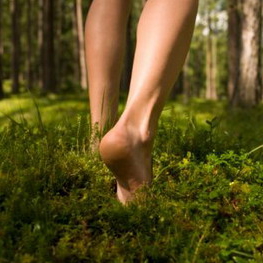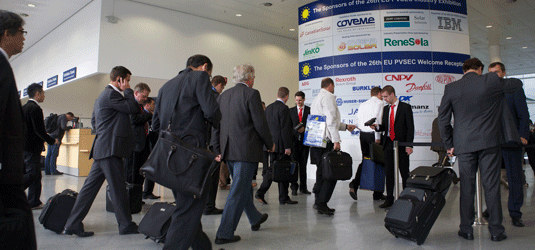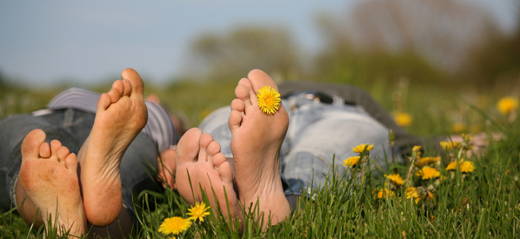Slowing down and finding time…
 It’s only natural that as we grow up, we learn to walk before we run. In returning to barefoot, though, many of us (myself included) do the opposite. As usual, this carries proverbial dangers: don’t run before you can walk… – ‘Don’t be ridiculous, of course I can walk barefoot!’ Isn’t this the thought crossing your mind right now? I know this is how I felt, at least, before taking the matter up a little more seriously. Surely if you can run barefoot, you must be able to walk barefoot as well! Maybe…
It’s only natural that as we grow up, we learn to walk before we run. In returning to barefoot, though, many of us (myself included) do the opposite. As usual, this carries proverbial dangers: don’t run before you can walk… – ‘Don’t be ridiculous, of course I can walk barefoot!’ Isn’t this the thought crossing your mind right now? I know this is how I felt, at least, before taking the matter up a little more seriously. Surely if you can run barefoot, you must be able to walk barefoot as well! Maybe…
But the situation isn’t quite so simple. Even if we spend a lot of time barefoot at home or in the garden, more consistent barefoot walking makes more stringent demands on the body, especially if we’ve grown up in shoes.
Can it really be that we’ve forgotten how to do that most natural and characteristic of human activities: to walk on our own two feet – or at least to walk on our feet as nature always intended? The sad fact is that, if we’ve grown up in a so-called ‘civilised’ culture, yes, we almost certainly have forgotten. Or more precisely, we never learnt how to walk naturally in the first place. Think about it: the moment a toddler is able to stand up, we stuff them into shoes to ‘protect’ their little feet. Have you ever handled baby shoes? They’re just about as flexible as reinforced concrete, preventing the toddler’s toes, arches and often even ankles from any kind of movement, natural or otherwise. They are straight-jackets for the feet. As a result, we can’t even say that the muscles in the foot and ankle atrophy over time, because they never have a chance to develop in the first place.
With the link to our biomechanical roots long severed, it might seem that we have no alternative besides hitting the books and reading up on the subject, as if studying a foreign language or the habits of an alien creature. As it so happens, this year (2013) has even witnessed publication of a whopping 400 page book: Barefoot Walking by Michael Sandler and Jessica Lee. Although there’s certainly a lot of good material inside, is barefoot walking really so difficult that we’d be lost without such a detailed user’s manual? Of course not. It’s the most natural thing in the world, after all. But we have been divorced from it our whole lives, which means that the journey of (re)discovery is going to take some time.
 I always used to consider myself pretty much a barefoot kind of guy, and at home you’ll never see anything on my feet, not even socks. Outside, when I step on to the street, I prefer sandals or, better yet, flip-flops, regardless of the weather. It’s only since taking up barefoot running that I realise that even sandals and flip-flops compromise the anatomical design created by millions of years of evolution. Just because your feet are exposed to the elements doesn’t mean you’re approaching anything like true barefoot. This isn’t some purist zeal shining through here, but rather a plain physiological fact.
I always used to consider myself pretty much a barefoot kind of guy, and at home you’ll never see anything on my feet, not even socks. Outside, when I step on to the street, I prefer sandals or, better yet, flip-flops, regardless of the weather. It’s only since taking up barefoot running that I realise that even sandals and flip-flops compromise the anatomical design created by millions of years of evolution. Just because your feet are exposed to the elements doesn’t mean you’re approaching anything like true barefoot. This isn’t some purist zeal shining through here, but rather a plain physiological fact.
I came into contact with barefoot walking as a result of barefoot running. For years my routine has been to walk the kids to school, and continue on a run from there. Although I fell in love with barefoot running on the very first occasion, my first experience with practical barefoot walking was less than head-over-heels. In fact, rather than the feeling that I was ‘coming home,’ something didn’t quite click. Stepping in the same manner as shoes – ie. with a heel strike – wasn’t comfortable, at least on the concrete pavement. And yet, it felt unnatural to adopt a mid- or forefoot landing, as in barefoot running. I was perplexed. At home, I always walk lightly and comfortably on the balls of my feet, but now, getting to school, it somehow felt overexerted and contrived. Then I realised: when going to school, we’re moving with a definite purpose – and usually late, hurrying, trying to catch up for lost time. At home, on the other hand, I just walk at whatever pace feels right. If I have to hurry to answer the telephone or the doorbell, I naturally spring into a loping jog instead.
This is the key. Barefoot, we simply are not designed to walk like New Yorkers or other stressed out, hustle-bustle city dwellers. Think of most four-legged animals, whether dog, cat, lion, tiger, cow or horse. Whereas we have only two means of moving (walking and running), they also possess a third: trotting. For animals, walking never involves a sense of urgency. When our cat, for instance, is getting about the house or garden, she does it at complete leisure: sniffing about here and there along the way, enjoying every last unhurried detail. If you call her for dinner, though, she breaks into an excited trot, springing with each step. True running or galloping is reserved for kill or be-killed situations, when she’s hunting or being chased herself. No wonder: galloping consumes much more energy! If you think about it, the same applies to pretty much any animal, whether predator or prey.
 So what about us humans? Well, if you want to get technical, it’s true that bipeds neither trot nor gallop; we simply either walk or run. But I would argue that ultimately the human body is no different from any animal’s. In other words, we are designed for stress-free walking, both physically and psychologically. I would also argue that the use of shoes has fundamentally altered our gait, so that the original role of ‘trotting’ has been absorbed into the broad genre of walking – as much as energetically it should correspond more closely to an easy run or jog.
So what about us humans? Well, if you want to get technical, it’s true that bipeds neither trot nor gallop; we simply either walk or run. But I would argue that ultimately the human body is no different from any animal’s. In other words, we are designed for stress-free walking, both physically and psychologically. I would also argue that the use of shoes has fundamentally altered our gait, so that the original role of ‘trotting’ has been absorbed into the broad genre of walking – as much as energetically it should correspond more closely to an easy run or jog.
The mechanical advantage provided by shoes with raised heels (no matter how minimal), allows us to step with an unnaturally large stride, landing ahead of our centre of gravity. The same applies to flat heels with rubber padding underneath, as in the case of flip-flops. Take a look at your own shoes: chances are they are both padded and raised at the heel. Shoes induce us to land at the heel, roll forward and push off from the toes. Heel to toe, heel to toe, propelling us forward. In this manner we are able to walk quickly and efficiently, with that modern sense of urgency you see everywhere.
Not only has the role of the gentle trot been usurped by shoes, but their design, with a relatively inflexible sole and raised heel, actually renders it biomechanically next to impossible. If you watch the people of barefoot cultures, they break into an easy trot the moment the pace of walking begins to attain a sense of purpose. They spring effortlessly forward, landing on the balls of their feet, just like a cat, their arches and ankles then acting like a spring or shock-absorber as their heels approach the ground. Modern shoes prevent this almost entirely. If we try to trot like this, the fixed sole inhibits or eliminates the arches’ cushioning motion, and the raised heel hits the ground more or less simultaneously along with the ball of the foot. We have no chance to break the impact, because the raised heel is already wedged between our sole and the ground.
Is it any coincidence that the word ‘jogging’ refers to slow running? Webster’s dictionary defines the verb ‘to jog’ as: ‘1. To move or shake with a push or jerk. 2. To cause to function with a jolt for a moment or in a series of disconnected motions…’ Does this sound like the fluidity of barefoot running? Of course not! When wearing shoes designed for heel striking, ‘jogging’ really is just that: a jerking, jolting motion!
Whereas the jarring stress of heel striking while running can clearly cause injury over time, the less intense impact involved in heel striking while walking is probably less detrimental. It isn’t so much that shoes are ‘evil’ and barefoot is ‘good,’ but rather a question of making a choice. Either wear shoes and possess the ability to walk quickly. Or walk barefoot – in which case walking should remain a strictly leisurely affair, with the possibility of trotting when swifter movement is required.
 No wonder walking barefoot to school felt unnatural. I was asking my body to do something it isn’t designed for. To walk quickly you either have to over-stride, which, when done barefoot, can cause plantar fasciitis or extensor tendonitis (more commonly known as Top of Foot Pain) in the long term, or you have to pick up the tempo of your walking stride to the point that it feels laboured – in which case a slow jog requires less effort and feels more natural.
No wonder walking barefoot to school felt unnatural. I was asking my body to do something it isn’t designed for. To walk quickly you either have to over-stride, which, when done barefoot, can cause plantar fasciitis or extensor tendonitis (more commonly known as Top of Foot Pain) in the long term, or you have to pick up the tempo of your walking stride to the point that it feels laboured – in which case a slow jog requires less effort and feels more natural.
We might ask why nature has not equipped us to walk more quickly. Perhaps it has something to do with the fact that for millions of years we had no need to do so. We weren’t in a perpetual hurry to get from point A to point B, meeting deadlines and quotas along the way, between each cup of coffee. Yes, there have always been occasions when man has had to run, but the base level of existential stress has never been higher than it is today, as unparalleled rates of stress-related disease from eating disorders to cancer bear witness. Perhaps our bodies are trying to tell us something…
We all have a choice. We can continue to earn, earn, earn and stay locked in the game of consumer society. We can continue to believe that we really do need that extra gadget or latest pair of shoes. Or we can opt for more time. Disconnected from ourselves and our roots, this can seem frightening if not downright impossible, blinded as we are through our societal addiction to money. After all, taking the plunge into empty time means we’ll have to face ourselves, perhaps for the first time. It can feel like staring into an empty vacuum. But it is only through choosing time that we’ll have time to rediscover our connection with ourselves and with the world around us. It is only through choosing time that you’ll have time to discover that there is more to you than just you. Taking off your shoes, feeling the Earth beneath your feet and going for a nice slow walk is a beautiful way to do just this.

When I started to walk more barefoot, I had the same realization, and I have recently found it stated in a German booklet on barefoot walking: forefoot walking too fast – at a modern fast walking speed – feels unnatural and weird. Much more natural to break into a very slow run instead. The modern tempo of walking fast in shoes is not a natural movement. At that tempo, a slow run or trot would be the natural response. So either take your time, or if you don’t have it, run … 🙂 …